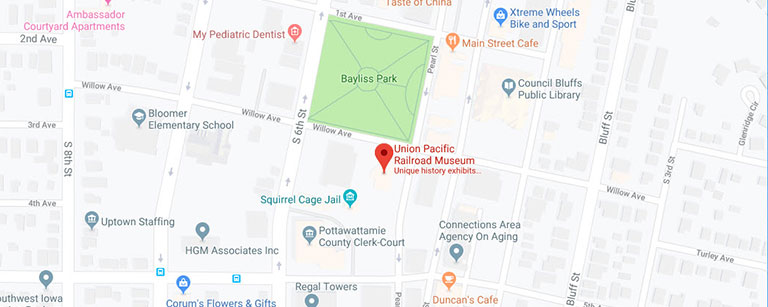The Not so Wild West: Firearm Regulation on the Union Pacific Railroad
When most people think about the Wild West, they think about the gun slinging cowboys and action heroes in a Hollywood Western. This vision of the West, however, did not come into existence until the early 20th century, encouraged by sensationalized dime store novels that later inspired Hollywood movies like the John Wayne Westerns (Jancer). In reality, firearms were often regulated in Western towns and along the railroads (Hochman, 1). New evidence from the museum’s archives indicates that as early as 1880, Union Pacific and Central Pacific had regulations limiting how passengers could transport firearms on board trains.
A jointly issued Union Pacific and Central Pacific Overland Route Passenger Timetable Booklet from 1880 lists that “Dogs and Guns will be transported in baggage car, by special arrangement of owner with train baggageman” (Union and Central Pacific 1880). By treating guns together with dogs, Union Pacific and Central Pacific approached the matter in terms of potential disruptions to the comfort and safety of other passengers on board by relegating their transport to the baggage car.
The 1880 passenger timetable is the earliest found evidence of an official policy by Union Pacific and Central Pacific regarding the transport of firearms on trains. By stipulating that all guns be transported in the baggage car, Union Pacific and Central Pacific introduced one of the more restrictive firearm regulations of the time among railroads (Hochman). By 1884, Union Pacific allowed passengers to carry firearms with them in coach if the guns were cased, “Guns in cases may be carried by Passengers in the Coaches without charge, or they will be checked free by baggage-agents as part of the usual baggage allowance. Guns uncased will be carried in baggage car only” (Union and Central Pacific 1884). This follows other railroad regulations of the time that limited a person’s access to a loaded firearm that could place other passengers in danger, such as the North Pennsylvania Railroad’s 1875 regulation that passengers could not take guns, dogs, or large bundles into the cars (Hochman, 11, 13).

PHYS_20230928_007: 1880 Overland Route UP and CP Passenger timetable
1880 Joint Union Pacific and Central Pacific Passenger Timetable pamphlet. In the late 19th century Railroads produced information booklets known as Passenger Timetables. These booklets included all the information that Passengers needed for their travels, listing the times that trains departed, advertising roundtrip “Tourist Excursions” to vacation destinations, and providing important information on fares and baggage restrictions. As such, the public announcements in these booklets provide an invaluable primary source of information on the railroad’s rules and regulations.
As the main artery of transportation across the continent, and for some the only means of transportation between towns, Union Pacific and Central Pacific’s approach to firearm regulation helped set the tone for much of daily life in the West. While firearms were seen as a necessity for hunting and protection in sparsely populated areas, in towns along the railroads, public safety was the paramount concern (Jancer).
The language of Union Pacific’s firearm regulations remained consistent throughout the rest of the 19th and the early 20th centuries. In 1915, UP updated its regulations to restrict all passenger firearms once again to the baggage cars, along with other baggage that could be disruptive in coach, “Guns (unloaded) in leather or wood cases, Saddles in bags, Golf, Baseball and other club paraphernalia; when accompanied by passenger, may be transported in baggage cars at owners’ risk, as part of passenger’s baggage” (Union Pacific 1915). By 1935, when the transportation of firearms by passengers became less common, Union Pacific dropped its language about firearm regulations from its passenger timetables entirely.
Bibliography
Hochman, Josh, “The Second Amendment on Board: Public and Private Historical Traditions of Firearm Regulation,” Yale Law Journal, Forthcoming, The Yale Law Journal Company, July 27, 2023, https://ssrn.com/abstract=4522818. Accessed October 19, 2023.
Jancer, Matt, “Gun Control Is as Old as the Old West,” Smithsonian Magazine, February 5, 2018, https://www.smithsonianmag.com/history/gun-control-old-west-180968013/. Accessed October 21, 2023.
Union and Central Pacific The Great American Overland Route Public Timetable, 1880, PHYS_20230928_007, A10.4.2, Public Timetables, Union Pacific Museum Collection, Council Bluffs Iowa, Accessed September 28, 2023.
Union and Central Pacific The Overland Route Public Timetable, 1884, A10.4.2, Public Timetables, Union Pacific Museum Collection, Council Bluffs Iowa, Accessed September 28, 2023.
Union Pacific The Overland Route Public Timetable, 1915, A10.4.2, Public Timetables, Union Pacific Museum Collection, Council Bluffs Iowa, Accessed September 28, 2023.

